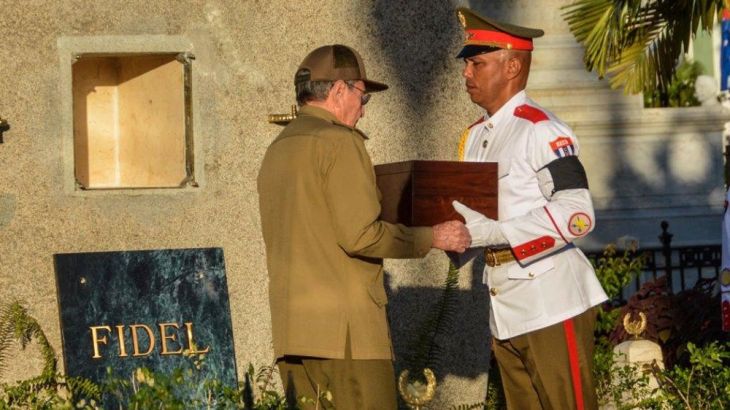Fidel Castro’s ashes interred in Santiago
Cuban leader’s ashes interred in a private ceremony in the city of Santiago, ending nine days of mourning.

Fidel Castro’s ashes were interred on Sunday at a cemetery in the southeastern city of Santiago – the cradle of the Cuban revolution – with the military firing a 21-gun salute for their fallen leader.
Initially the act at the cemetery was due to be carried live on television, but hours before official media announced it would be “solemn and private”.
Keep reading
list of 4 itemsWhat’s going wrong in Cuba? | Start Here
Cuba has a new leader and it’s not a Castro
A new era in Cuba?
An urn containing Castro’s ashes was brought by soldiers to the cemetery of Santa Ifigenia in Santiago, 800km southeast of Havana. Thousands of people lined the road, waving Cuban flags and shouting “Long live Fidel!”.
REPORTER’S NOTEBOOK: The Fidel Castro that I knew
The remains of the man who ruled Cuba for a half-century left the Plaza of the Revolution in the eastern city at 6:39am local time, more than 20 minutes ahead of their scheduled departure.
|
|
Al Jazeera’s Lucia Newman, reporting from Santiago, said members of Castro’s family and top government officials close to the former leader attended the private ceremony.
“This is very much a state affair, but the funeral itself is not a state funeral,” Newman said.
Castro died on November 25 aged 90. His final resting place is near the mausoleum of 19th century independence icon Jose Marti and other national heroes.
After two days of events in Havana, Castro’s funeral cortege departed on a three-day journey east, retracing the route that the triumphant rebels took upon overthrowing US-backed Fulgencio Batista in 1959.
On Saturday evening, President Raul Castro, his brother and successor, said “millions” had come out to pay tribute.
OPINION: Fidel Castro in context
In keeping with his wishes, Castro’s image will not be immortalised with statues, nor will public places be named after him, his brother said on Saturday.
Crowds have greeted the caravan along the whole route, with volunteers sprucing up bridges and houses
With his brother at his side, Castro began his revolution on July 26, 1953, with a failed assault on the Moncada barracks in Santiago.
He went on to build a Soviet-sponsored communist state 145km from the United States and survived a half century of US attempts to topple or kill him.